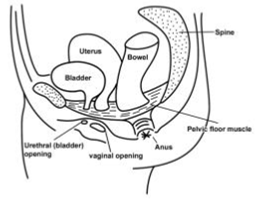Physiotherapy – Looking after your pelvic floor when you have had a baby
Looking after your pelvic floor when you have had a baby
The pelvic floor is a group of muscles, which lie like a hammock at the base of the pelvis, running from the pubic bone at the front to the tailbone at the back. There are three openings in the muscle – the anus (back passage), vagina (birth canal) and urethra (bladder outlet).

Illustrated diagram of pelvic floor
What do they do?
- These muscles support the pelvic organs (bladder, uterus (womb) and bowels) to reduce the risk of prolapse. They also help to control the bladder and bowels.
- Healthy pelvic floor muscles may also help improve your sex life.
- Pelvic floor muscles should be kept strong just like any other muscle within the body.
Symptoms to look out for:
- Leaking urine (wee) on coughing, sneezing, lifting or running (even small amounts)
- Sudden urgent or frequent need to pass urine (wee)
- Feeling ‘something coming down’ or a ‘dragging sensation’ in the vagina – (prolapse)
- Being unable to control leakage of wind or ‘poo’ from the bowel
- Lack of sensation with sex
- Pain with sex
The first 24 hours after the birth
- Empty your bladder every couple of hours. The feeling of wanting to pass urine may not return straight away. You must tell your midwife if you are unable to empty your bladder within 6 hours following delivery.
- Do short pelvic floor muscle squeezes at first. It will help any swelling to go down and can help to heal tears and stitches. Lying on your side is a comfortable position to start exercising.
- Keep the perineum clean and dry until healed using only warm water to wash. Do not use any creams, gels or soap in the area as they can cause infection and irritation to new skin. Stitches should dissolve within 10-14 days – discomfort should reduce daily. If not, please ask your midwife or GP to check them at your post-natal appointments.
- Use medication as advised by your midwife or doctor if your perineum (the area between the vagina and back passage) is uncomfortable. This will help to keep you mobile, which in turn helps the healing process.
- You may be advised to use medihoney on stitches to help reduce the risk of infection – please refer to the Perineal care booklet provided on the ward for information on this and other medication.
- You could also try using an ice-pack – this will help to reduce swelling and discomfort and ease bruising. When you are at home you can use a damp frozen pantyliner or a ready-made gel ice pack in a damp clean flannel and placing it on the perineum (the area between the vagina and anus) for 5 minutes, while you are lying down. Do not sit on it.
Caution: ice can burn so do not place directly on the skin or leave it in place for longer than 5 minutes.
- If you have difficulty controlling your bladder or bowels after delivery, please ask your GP /Midwife to refer you to Pelvic Health physiotherapy.
- You may feel worried about emptying your bowels for the first time.
- Using a wad of toilet paper or maternity pad, support the area just in front of your back passage to support it while you gently bear down with a series of short pushes (rather than straining), may make you feel more comfortable.
If you have a catheter, wait until it has been removed before you start your pelvic floor exercises.
If you have stitches, you can still do these exercises as they will help with the healing and reduce swelling in the area, but it is important to start gently in the first few days after delivery.
How do I find my pelvic floor muscles?
It is important to know you are exercising the right pelvic floor muscles.
Find a comfortable position sitting upright with your feet flat on the floor or alternatively lying on your back or side with your knees bent.
Imagine that you are trying to stop yourself passing wind and urine at the same time, drawing the muscles upwards and forwards starting from the back passage.
It is important not to hold your breath.
Try not to clench / squeeze the buttock muscles or hold your breath.
How to exercise the pelvic floor muscles
Pelvic floor exercises should include long squeezes as well as short, quick squeezes, making sure you let go / relax the muscle between each squeeze. Aim to complete both long and short squeezes 3 times a day.
Don’t try to stop and start the flow of urine whilst on the toilet – this can interfere with normal bladder function.
Long squeezes
- To begin, aim to hold the squeeze for 5 seconds. Let go. Relax for a few seconds.
- Repeat 5 times.
- As the muscle gets stronger, aim to hold for up to 10 seconds and up to 10 repetitions.
Short, quick squeezes
- Quickly squeeze the pelvic floor and then let go immediately.
- To begin with, aim to repeat 5 short squeezes. Make sure you relax the pelvic floor between each squeeze. As the muscle gets stronger, aim for 10 short squeezes.
- Use the NHS approved ‘Squeezy’ App available on all smart phones / mobile devices to help remind you to complete exercises using the exercise plan described above.
Recovering well
- Do your pelvic floor exercises regularly. The hardest part is remembering to do them – a good time could be every time you feed your baby or wash your hands.
- Tighten your pelvic floor when you do any activity that requires effort – e.g. cough, sneeze or lift. The reflex that makes you do this naturally can stop working after having a baby. Regular practice protects your pelvic floor and helps to train it to work automatically again.
- Avoid heavy lifting where possible – e.g. vacuuming, wet washing, car seats.
- Avoid sit ups and high impact exercise for at least 3 months after the birth – it can take the pelvic floor this long or more to return to its previous pre-natal strength.
- Drink at least 1.5 – 2 litres of fluid a day, which is about six to eight drinks. If you are breast-feeding or it is very hot you should maintain good hydration by drinking according to your thirst and ensuring that you have lightly coloured urine.
- Avoid constipation – it puts pressure on the pelvic floor. Ask your midwife for guidance if you struggle with this.
- Once your pelvic floor muscles are back to full strength, you will need to do one set of ‘fast’ and ‘slow’ exercises every day to keep them strong. Aim for 10 fast and 10 slow holds for 10 seconds.
For further advice and safe exercises, including audio link – please refer to:
Are you at risk of developing pelvic floor problems?
- Did you have urinary leakage in pregnancy?
- Did you struggle with continence – bladder or bowel in pregnancy or post-natally?
- Does / did your mother have continence or prolapse problems
- Did you have a large baby (over 4kgs) or an instrumental (forceps/ventouse) delivery?
- Did you have a very long or very fast ‘pushing’ (second) stage of labour?
- Do you suffer regularly from constipation?
If you answered ‘yes’ to any of these questions, you may benefit from specialist advice.
If you would like further help please refer to our online resource via the link or QR code below www.bedfordshirehospitals.nhs.uk/our-services/maternity-2/pelvic-health/ or ask your GP/Midwife or health visitor to refer you to our specialist Pelvic Health physiotherapist.

QR code leads to pelvic health section of Trust website

QR code leads to Pelvic Obstetric & Gynaecological Physiotherapy (POGP) website
We ask for information about you so that you can receive proper care and treatment. This information remains confidential and is stored securely by the Trust in accordance with the provisions of the Data Protection Act 2018/GDPR. Further guidance can be found within our privacy notice found on our Trust website:
